Long before paramedics in green uniforms and flashing blue lights became part of everyday life, a man in Burslem quietly changed the course of emergency care forever. In 1874, Hiram Syson – a Crimean War veteran and town hall caretaker – became England’s very first ambulance man. Operating from Burslem Town Hall, Syson ran the country’s first organised civilian ambulance service, years before any official training body or brigade had even been formed.
This is a local story with national importance. It began on the streets of Burslem and helped lay the foundation for the modern ambulance service we know today. From war hero to public servant, Hiram’s journey is one of duty, compassion and innovation – and it all started right here in the heart of the Potteries.
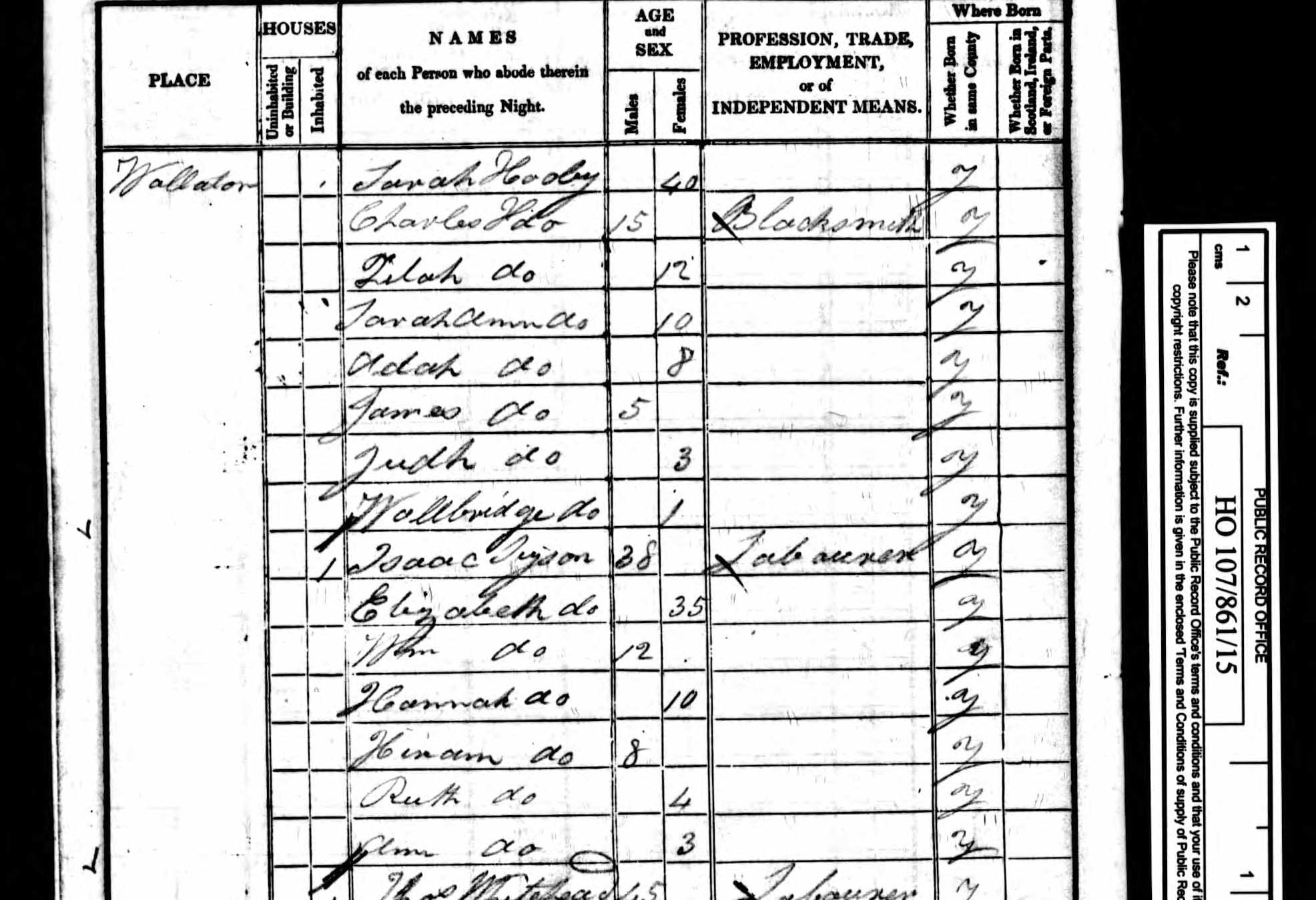
Early Life and Military Service
Hiram Syson was born on 22 February 1833 in Derbyshire. His father, Isaac Syson, was an agricultural labourer, and his mother Elizabeth raised their children in rural surroundings. By the time of the 1841 census, the Syson family had moved to Wollaton near Nottingham. Hiram was one of several children: John, Hannah, Ruth, and Ann. The move to Wollaton placed the family closer to growing industrial centres, although they still lived modestly by agricultural means.
At the age of eighteen, in 1851, Hiram left home and enlisted with the 47th Regiment of Foot in Coventry. This decision marked the beginning of a life shaped by discipline, duty and eventually public service. His enlistment brought him into the ranks of the British Army during a time of growing tensions abroad. Not long into his service, Hiram transferred to the 57th Regiment of Foot – famously known as ‘The Die-Hards’ for their bravery under fire.
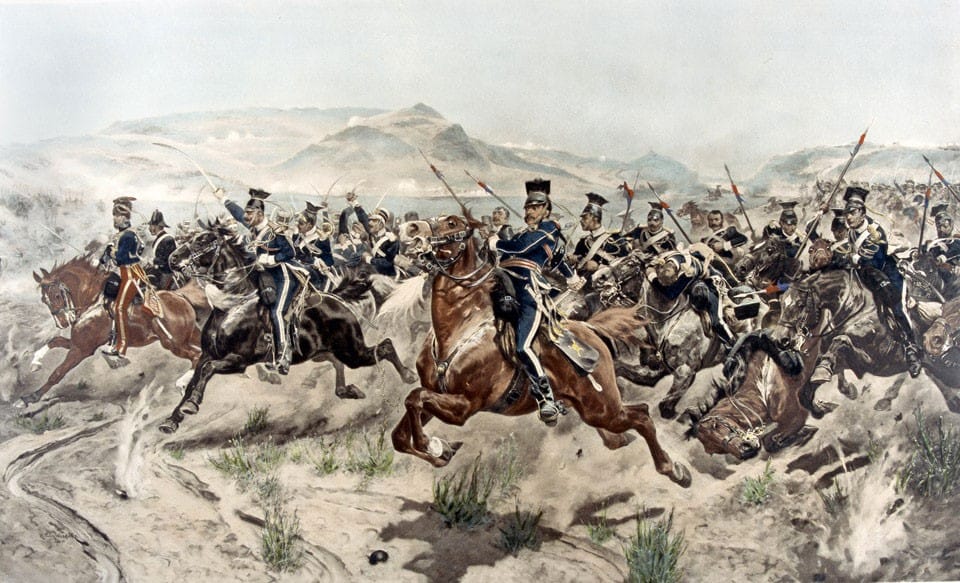
In 1854, the Crimean War broke out, and Hiram’s regiment was deployed. On 14 September 1854, he landed in Crimea as part of the 4th Infantry Division under Lieutenant General Sir George Cathcart. He saw action at the Battle of Alma on 20 September, just days after arrival. Then came Balaklava on 25 October – famous for the Charge of the Light Brigade – and Inkerman on 5 November, where Hiram fought in bitter and chaotic hand-to-hand combat.
As the brutal winter of 1854–55 set in, he likely took part in the Siege of Sebastopol. While official records don’t confirm this directly, the fourth bar on his Crimea Medal indicates his presence. Altogether, Hiram was awarded the Crimea Medal with four bars – Alma, Balaklava, Inkerman and Sebastopol – a notable honour recognising the hardship and bravery of those in prolonged combat.
After Crimea, his regiment was sent to Malta in June 1856 and later ordered to India to help suppress the Indian Rebellion of 1857. However, it is believed Hiram returned to Britain before this deployment, likely due to injury or completion of his overseas duty.
By 1859, he was stationed at Peterborough. Though still serving, he was no longer on foreign soil, and his future in civilian life was beginning to take shape. His military experience – especially as a hospital orderly during the war – would eventually become the foundation for his pioneering role in ambulance services back in England.
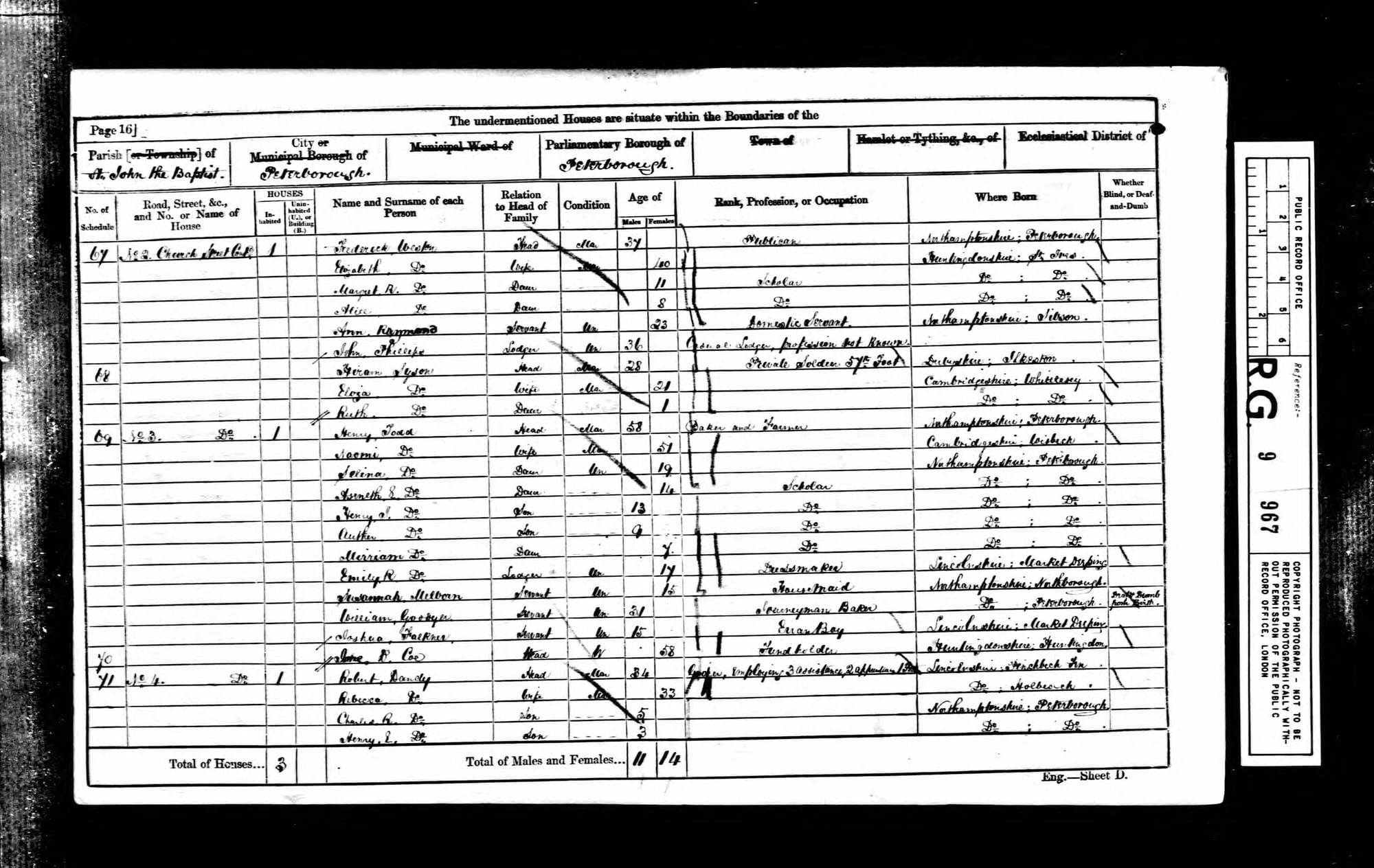
Marriage and Family Life
In January 1860, Hiram Syson, aged 26 and a serving soldier, married Eliza Timms, a 20-year-old woman from Whittlesey in the Cambridgeshire Fens. Whittlesey was a small market town surrounded by flat agricultural land and ancient waterways. Eliza was born in the autumn of 1839 in Thoroughfare Yard – a small lane connecting Broad Street and Church Street, right beside the town's school. She was the eldest of ten children born to John Timms, a labourer from Ivy Lane, and his wife Elizabeth Meggott, who had married at St Mary’s Church, Whittlesey, in 1838.
As a child, Eliza would have seen Whittlesey changing, with many families struggling to survive on rural wages. By 1843, the Timms family had moved to High Causeway, and by 1851 they were living in Inhams End. Sometime around 1857, the family (apart from Eliza and her younger brother Charles) moved north to Hareholme, near Newchurch in Rossendale, Lancashire, where John found work at Hareholme Cotton Mill.
Recruitment agents or 'council men' would appear in Whittlesey’s Market Place early in the morning, selecting men and their families to travel across the country for guaranteed mill work. John and Elizabeth Timms were among those who left in hope of better opportunities, leaving Eliza and Charles behind in Whittlesey.
It was during this time that Eliza met Hiram, who was stationed in Peterborough after returning from active service. Their marriage in January 1860 was quickly followed by the birth of their daughter, Ruth Syson, who arrived on 7 April 1860 in Whittlesey – where her mother’s family still had roots.
By the time of the 1861 census, Hiram, Eliza, and baby Ruth were living on Church Street in Peterborough. Hiram was still serving in the 57th Regiment of Foot and had not yet left the military. During this period, he achieved promotion to corporal – a testament to his reliability and conduct. This experience, particularly in leadership and first aid during his time as a hospital orderly, would lay important groundwork for his later civilian role in Burslem.
Though their lives had started in very different places – Hiram in Derbyshire and Eliza in the Fens – their shared journey brought them to Staffordshire, where they would unknowingly shape the future of emergency medical care.
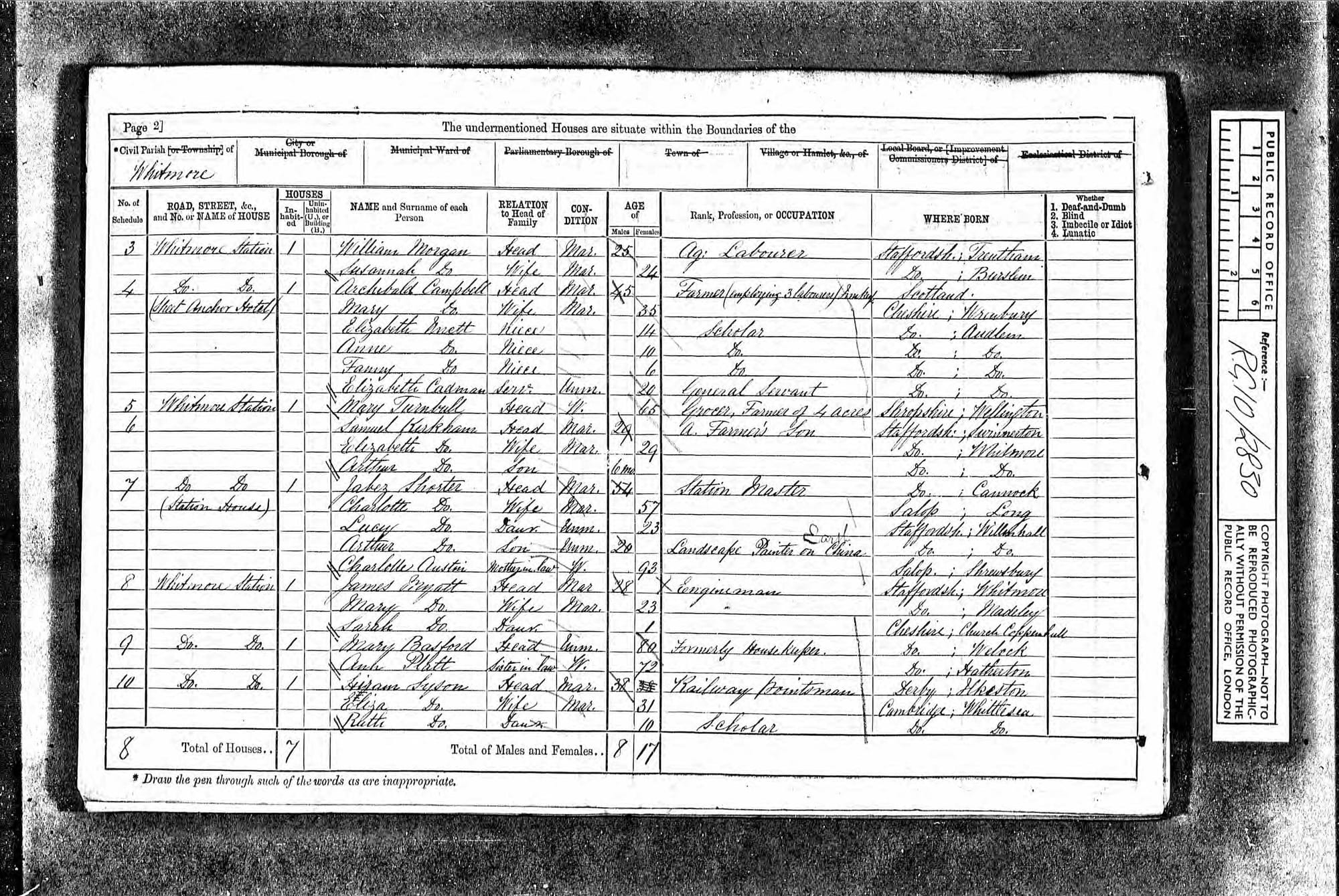
Moving to Staffordshire
By the end of the 1860s, after more than two decades of military service, Hiram Syson transitioned into civilian life. Around 1870, he secured employment with the London and North Western Railway, one of the most important railway companies of the Victorian era. He worked as a railway pointsman, a responsible role that required sharp attention to safety and the operation of track switches for passing trains.
At the time of the 1871 census, Hiram, Eliza, and their daughter Ruth were living at Whitmore Station in Staffordshire. This rural posting likely suited Hiram's disciplined, practical character, and the family settled into their new life. However, change was soon on the horizon.
In late 1872, the Local Board of Health in Burslem advertised a position for a hall keeper at the recently expanded town hall. The Staffordshire Advertiser reported that forty people applied for the role, but it was Hiram and Eliza who were chosen. Hiram’s military background, experience as a caretaker, and proven reliability made him an ideal candidate.
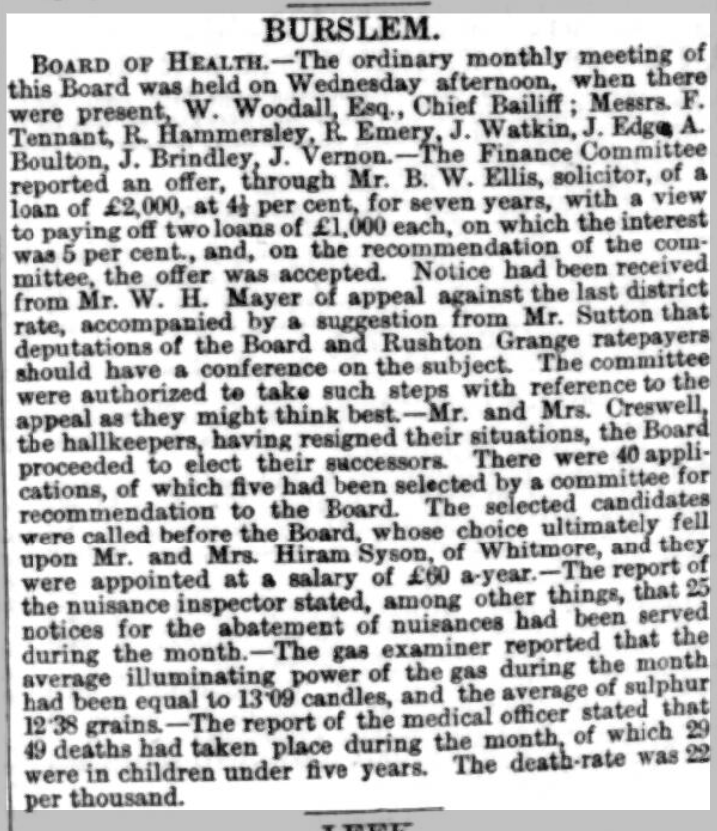
On 7 December 1872, the Board officially appointed Hiram and Eliza to the post, offering a salary of £60 per year. Their duties would have included overseeing the town hall, maintaining order, and assisting with public events, civic duties, and daily operations. For Hiram, this marked not only a stable new chapter in his working life, but one that would place him at the very heart of the community.
The Syson family moved into accommodation provided at Burslem Town Hall. This move would soon set the stage for Hiram to make history. Within just two years, he would become known as England’s very first ambulance man – and the Town Hall, his place of work and residence, would become the birthplace of civilian ambulance services in Britain.
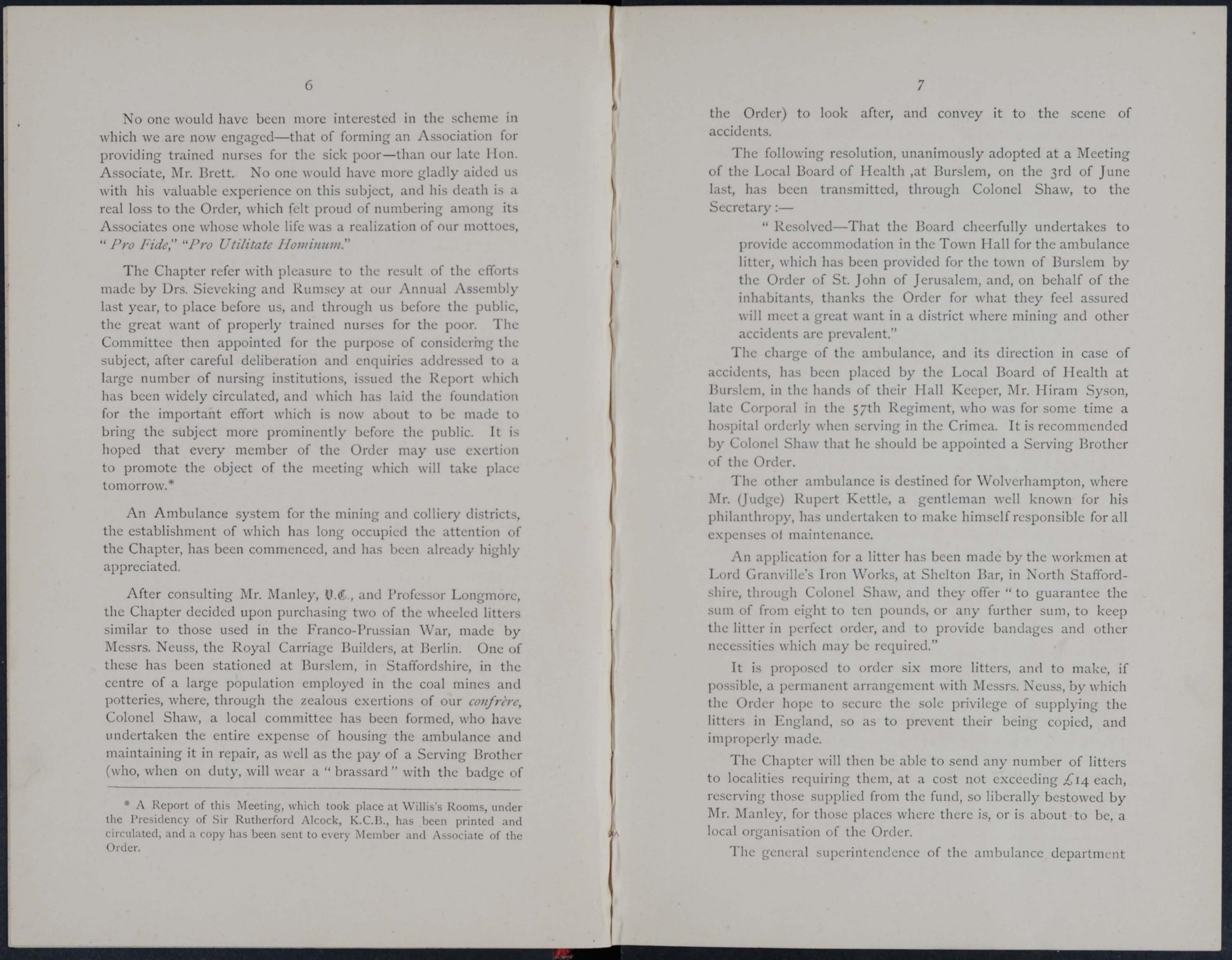
The First Civilian Ambulance Service
In the early 1870s, the Order of St John in England was seeking a meaningful way to express its charitable ethos, guided by the motto Pro Utilitate Hominum – "For the benefit of mankind." One proposed initiative was the introduction of an ambulance service for the general public, particularly for use in industrial towns and mining areas where workplace accidents were frequent and often fatal. However, this forward-thinking idea was initially met with resistance.
In 1872, the Order consulted senior surgeons, including Mr F.C. Skey of St Bartholomew’s Hospital. These medical professionals advised that the logistical and clinical challenges of implementing such a service were too great, leading the Order to shelve its plans temporarily.
Despite the setback, momentum quietly continued behind the scenes. By 1874, the Order revisited its ambulance scheme, this time drawing inspiration from the Franco-Prussian War, during which innovative wheeled litters had been used to transport wounded soldiers. Two of these litters, manufactured by Messrs Neuss – royal carriage builders in Berlin – were purchased and shipped to England.
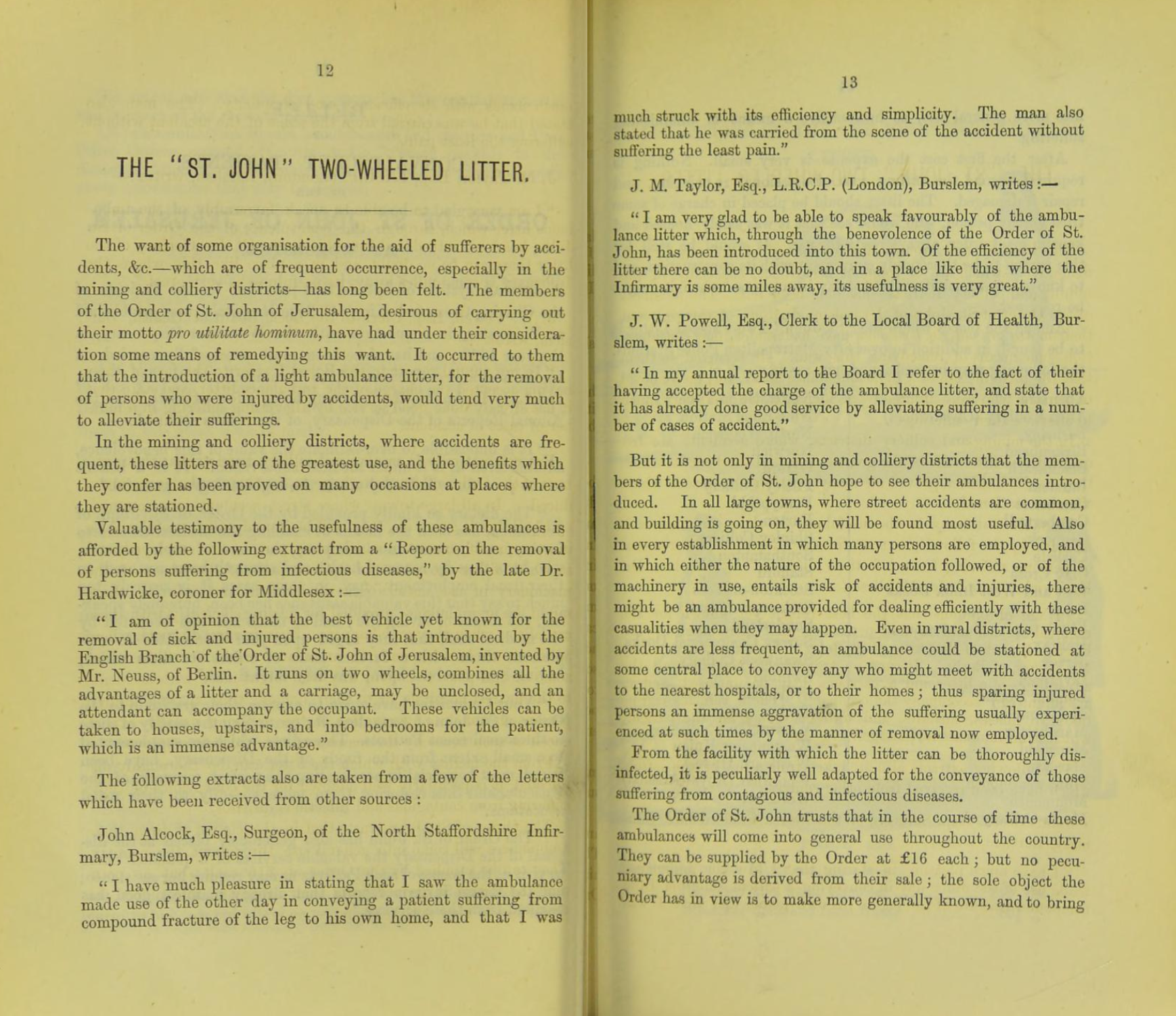
One of these was assigned to Burslem in North Staffordshire, a town deeply rooted in the coal and pottery industries. The region was plagued by workplace injuries and lacked any formal emergency transport system. The decision to base one of the first trial ambulance services in Burslem was not coincidental – it was made possible through the determined efforts of Colonel Shaw, a local advocate, and a committee that pledged to cover all maintenance and staffing costs.
On 3 June 1874, the Burslem Local Board of Health passed a formal resolution welcoming the ambulance and agreeing to house it at the Town Hall. Their statement read:
"That the Board cheerfully undertakes to provide accommodation in the Town Hall for the ambulance litter, which has been provided for the town of Burslem by the Order of St John of Jerusalem, and, on behalf of the inhabitants, thanks the Order for what they feel assured will meet a great want in a district where mining and other accidents are prevalent."
The responsibility for operating the new ambulance fell to Hiram Syson. With his military background, proven reliability, and first-hand medical experience as a hospital orderly during the Crimean War, he was an obvious choice. His official title was Hall Keeper, but he now became something much more: the first man in England to manage and operate a civilian ambulance service.
Hiram underwent voluntary training in the use of tourniquets and splints – long before the formal teaching of first aid existed. The ambulance litter itself was a two-wheeled cart that could be pulled or pushed by hand, designed to safely carry patients to hospital while minimising their pain.
When on duty, Hiram wore a brassard – a cloth armband bearing the badge of the Order of St John – marking his role in this experimental but vital new service. On 3 November 1874, his commitment was formally recognised when he was appointed a Serving Brother of the Order. He was only the second person in England to receive this honour, after the Order’s caretaker in London.
This appointment marked a historic moment. With Burslem as its base, Hiram Syson’s operation became the first organised, trained, and publicly available ambulance service in the country – created for civilians, run locally, and built entirely on the goodwill of community and volunteerism.
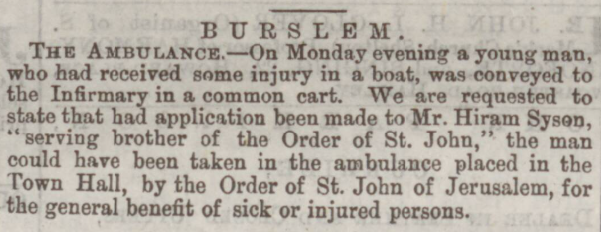
Early Operations and Public Reception
The first operational use of the Burslem ambulance service – and the beginning of a national movement – was recorded on 9 June 1874. Although that early call-out was not initially carried out by Hiram himself, the Staffordshire Sentinel later reported on a young man who had been transported to the infirmary using a common cart. The article made it clear that had Hiram been contacted, the new ambulance would have been used instead, suggesting that awareness of the new service was still developing among the public.
As the local population became more familiar with the purpose of the two-wheeled litter stationed at the Town Hall, requests for Hiram’s services increased. His training in applying splints and tourniquets allowed him to offer care that, while basic by today’s standards, was revolutionary for its time. He operated the ambulance with care and dignity, treating patients not merely as casualties to be moved but as individuals in need of respect and compassion.
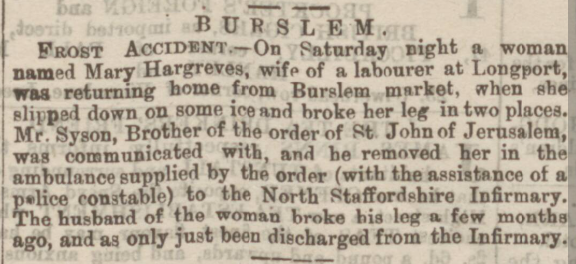
The Order of St John's 1875 Annual Report documented nine uses of the ambulance over a twelve-month period – a small but significant start. The first official press report of its use came on 23 November 1874. In this instance, Hiram transported a woman who had broken her leg in two places to the North Staffordshire Infirmary. The event was covered in the Staffordshire Sentinel and marked the first public recognition of Hiram’s pioneering role.
The report from the Order highlighted Hiram’s commitment:
“He has proved himself most zealous and efficient and has much pride in his connection with the Order… The Chapter has recently awarded him a small gratuity.”
The Order also acknowledged that Hiram was voluntarily receiving further instruction in the application of splints and tourniquets, showing both his willingness to learn and his deep dedication to the role.
The people of Burslem began to see Hiram not just as the town hall keeper, but as someone dependable in moments of pain and crisis – the one to call when accidents occurred in the mines, potbanks, or streets. Slowly but surely, the image of the ambulance man became one that embodied compassion, professionalism, and local pride.

Fire Brigade Leadership
In June 1875, the responsibilities on Hiram Syson’s shoulders expanded once again when he was appointed Superintendent of the Burslem, Longport and Cobridge Fire Brigade. His reputation for reliability, discipline, and calm under pressure made him the ideal choice to lead this vital public service. At a time when fires in tightly packed industrial towns could devastate entire streets or businesses, the role of fire superintendent carried great importance and public trust.
Almost immediately after his appointment, Hiram was called into action. In August of that year, a woman tragically lost her life after her mattress caught fire. Hiram responded swiftly, arriving at the scene with the Burslem fire engine. Though his services were ultimately not required on this occasion, his quick reaction demonstrated the level of preparedness and urgency with which he approached his new responsibilities.
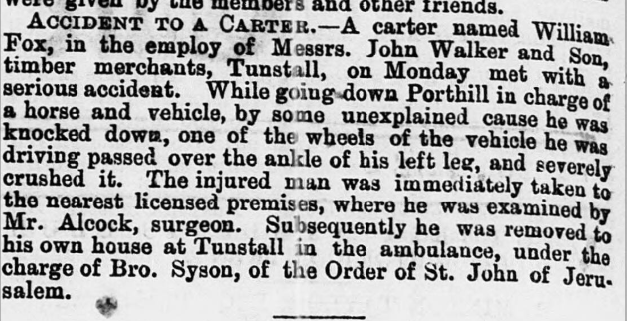
Later that year, in November, Hiram once again demonstrated the versatility of his dual role. When a local man, William Fox, suffered a crushed ankle while travelling down Porthill, he was taken to the nearest licensed premises for initial medical attention. Afterwards, Hiram transported him to his home in Tunstall using the ambulance litter. This incident highlighted how his duties as both ambulance man and fire superintendent were often intertwined, as he provided emergency care and transport for those in need across multiple types of incident.
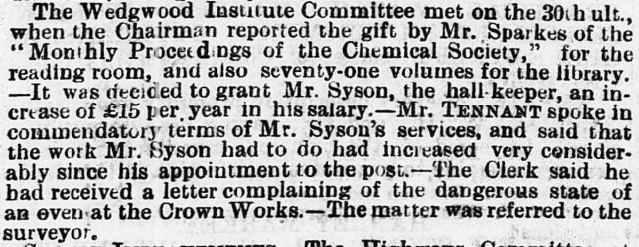
On 30 November 1875, in recognition of his growing responsibilities and continued dedication, the Local Board increased Hiram’s salary by £15 – a significant raise at the time. One board member, Mr Tennant, spoke in praise of Hiram’s expanding role and commended his reliability, suggesting that few others could manage the range of duties as effectively as he had.
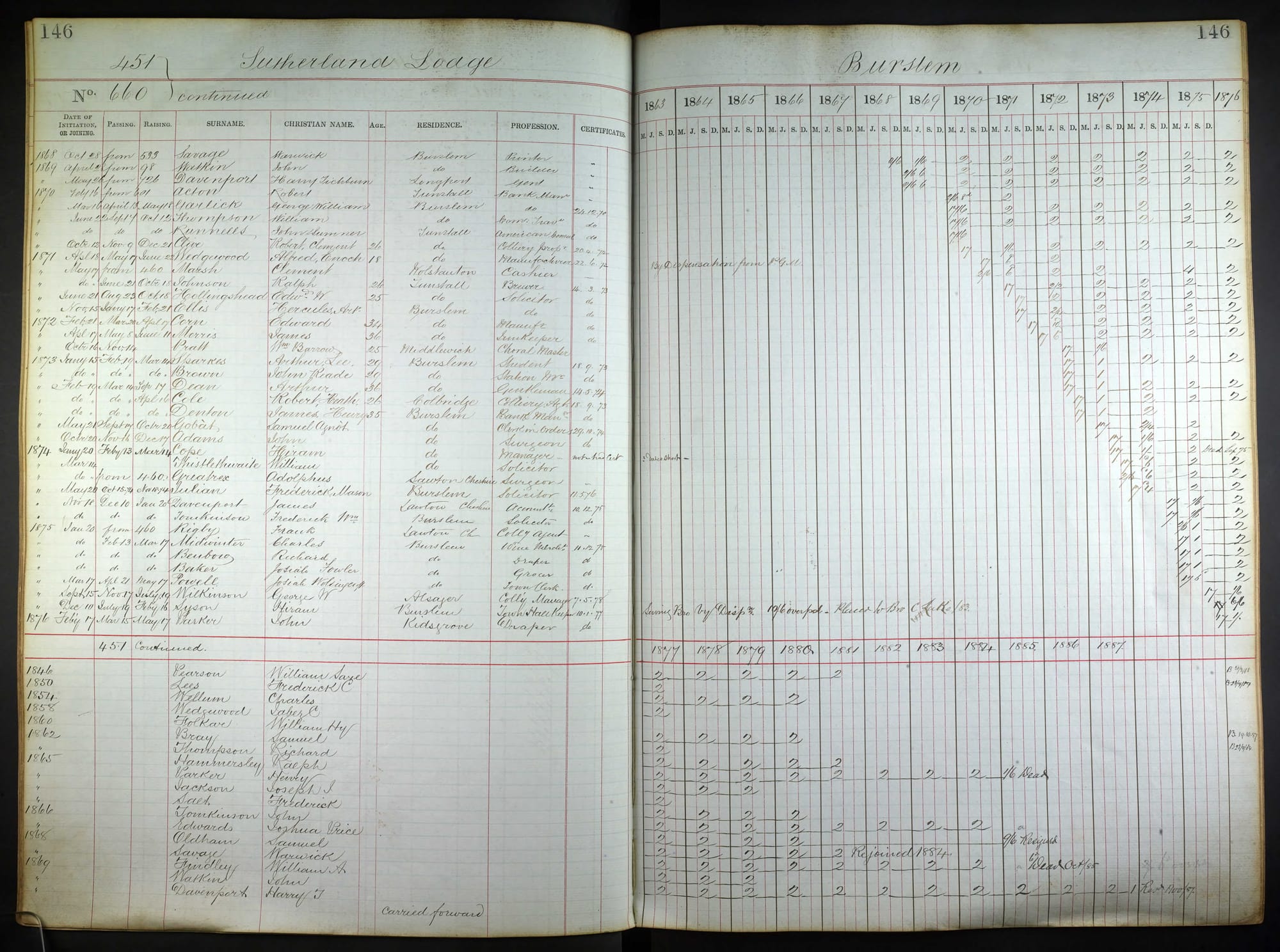
Just ten days later, on 10 December 1875, Hiram was initiated into the Burslem Sutherland Lodge of Freemasons. His occupation was listed as "Town Hall Keeper," but by this point, he had already become much more than a caretaker. He was a trusted civic figure, a leader in both fire and medical emergency services, and now, a respected brother within the town’s influential Masonic community. His inclusion in the Freemasons reflected not only his status but also the high regard in which he was held by his peers and the town’s civic leaders.

Distinguished Service and Recognition
On 6 February 1876, Hiram Syson was once again called to the front lines of local emergency response. A serious fire broke out in the manufacturing premises situated behind the District Bank in Burslem. It was discovered shortly before nine o'clock in the evening, and without delay, Hiram rallied the fire brigade and reached the site by ten past nine. The brigade connected hoses to a hydrant in the Market Square and worked swiftly to bring the fire under control. The flames threatened to engulf nearby buildings, including the bank itself.
Despite the severity of the fire, Hiram’s leadership and tactical decision-making prevented disaster. As water began to douse the flames, he assessed the situation and determined that reinforcements from Hanley and Tunstall were not required. The blaze was finally subdued by mid-afternoon the following day, after several hours of intense work from the firemen under his command. A later report credited Hiram’s "judicious treatment" with saving the surrounding buildings from destruction.
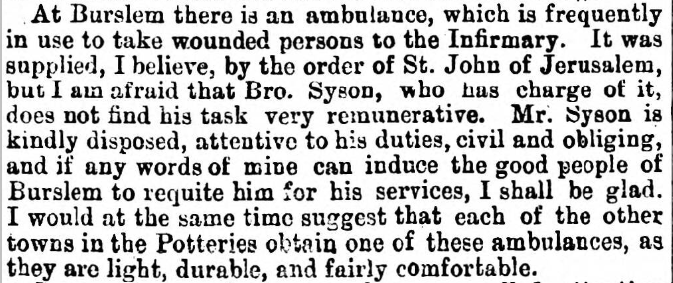
In April 1876, a letter published in the Staffordshire Sentinel praised Burslem's innovative approach to emergency care and urged other towns in the Potteries to follow its lead.
These public tributes, alongside the official recognition from the Order, reinforced Hiram’s growing reputation as one of the town’s most dedicated public servants. He had become a dependable figure in the lives of the townspeople – not only as the keeper of the Town Hall and a firefighter, but also as the go-to man in times of injury or disaster.
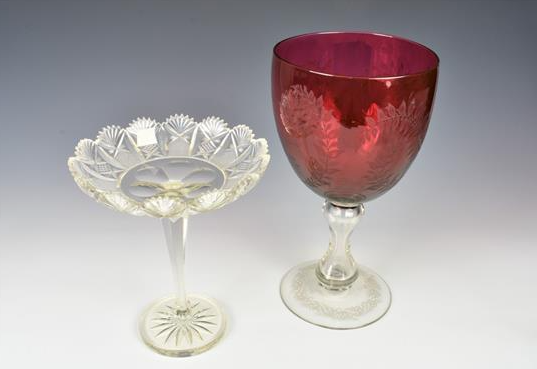
On 22 February 1879, the day of his 46th birthday, Hiram was honoured in a touching ceremony by the fire brigades of Burslem, Cobridge, and Longport. The firemen presented him with an engraved address and a selection of beautifully crafted gifts, including a coloured and engraved glass goblet, a glass cigar-holder, and a painted china teacup and saucer. The address, signed by over 40 firemen, praised his “kind and gentlemanly bearing, firmness and discretion on all emergencies,” and acknowledged his generous spirit and effective leadership.
The presentation was not just a token of appreciation – it was a sincere expression of respect from the men who had worked under his guidance and had come to admire his dedication and humility. Decades later, in 2019, one of those very gifts – the cranberry glass goblet – resurfaced and was auctioned by Martel Maides Auctions in Guernsey, a poignant reminder of Hiram’s impact and the deep gratitude felt by those he led.
By the end of the 1870s, Hiram Syson had become one of Burslem’s most admired public figures – a man whose actions spoke louder than words, and whose legacy was already being celebrated in his own lifetime.
Illness, Death and Legacy
As the 1870s drew to a close, Hiram Syson, once a strong and stoic figure, began to suffer from a severe and painful illness. Though details of his condition remain unknown, it is clear that his health deteriorated significantly over the course of a year. Despite this, Hiram never stepped back from his duties. He continued to oversee the Town Hall, operate the ambulance, and lead the fire brigade, even as he battled ongoing pain and fatigue.
His dedication was unwavering. In fact, his final report to the Order of St John, submitted only days before his death, noted that he had recently transported a crushed patient five miles using the ambulance litter. This commitment to others – even in his weakened state – defined his final year of life.
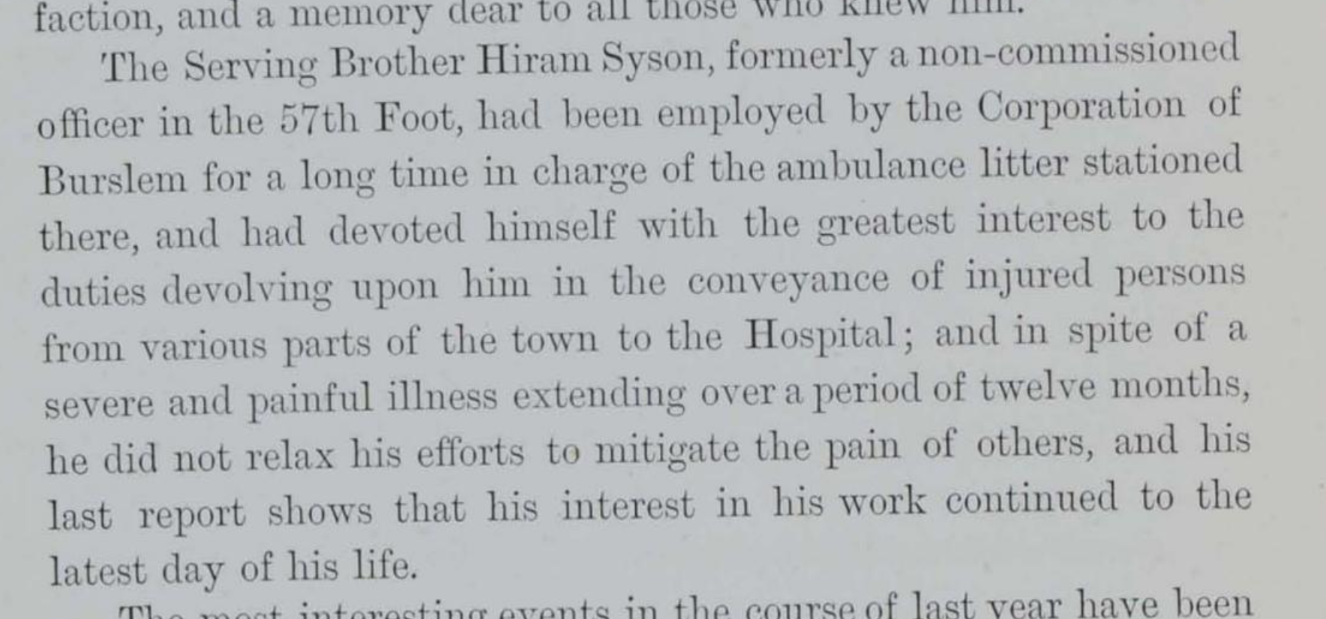
On Monday 7 June 1880, Hiram Syson died at the age of 47. His passing was met with widespread sadness across Burslem. Four days later, on Friday 11 June, his funeral became a major civic event. The cortege included the mayor, members of the Corporation, the fire brigade, Chief Superintendent Hill and Inspector German, sergeants and constables of the local police, and many townspeople. Their presence spoke volumes about the respect and gratitude Hiram had earned throughout his years of public service.
The Burslem ambulance station ceased operations following Hiram’s death. Without his leadership and presence, the voluntary model could not easily continue. Yet this was not the end of the movement – it was only the beginning.
In 1881, just one year after Hiram’s death, the Order of St John formally established its Ambulance Department under the guidance of Surgeon-Major William George Nicholas Manley VC. The first official framework for civilian ambulance services was put in place.
By 1884, the Potteries Centre of the newly formed St John Ambulance Association was established, and three years later in 1887, the uniformed St John Ambulance Brigade was formed. Fittingly, Burslem – the town where it had all begun under the quiet determination of one man – was home to one of the first corps.
Hiram Syson had lived and died without seeking fame, but his example became the foundation upon which a national institution was built. He showed that ordinary people, with training and compassion, could save lives – a revolutionary idea in Victorian Britain, and one that would shape generations to come.

Family After Hiram
After Hiram’s death, Eliza remained in Burslem for a few more years, continuing to let out rooms at their home on Portland Street. Eventually, she relocated to St Annes-on-the-Sea in Lancashire, where many members of the Timms family – including her parents and siblings – had moved years earlier from the Fens to work in the Lancashire cotton mills. There, Eliza was reunited with her extended family and lived out the remainder of her life in quieter surroundings.
Ruth married Henry Heap, a builder, in 1884. They had three children: John Hiram (1885), Bertha (1887), and Mary Dorothy (1896). Eliza died in 1929, aged 89, having outlived Hiram by nearly fifty years.John Hiram Heap lived until 1953. After his death, Hiram’s cherished commemorative goblet – the same one presented to him on his 46th birthday by the fire brigade – resurfaced decades later in Guernsey, where it was sold at auction. How it arrived there remains a mystery, but its survival serves as a poignant reminder of a man whose work once shaped the future of emergency care in Britain.
Tragedy later struck the family when Eliza’s brothers, Charles and Reuben Timms, both lifeboatmen, were killed in the RNLI’s worst disaster – the Mexico lifeboat tragedy of 1886. Both were crew of the ‘Laura Janet’ which capsized, claiming 27 lives.
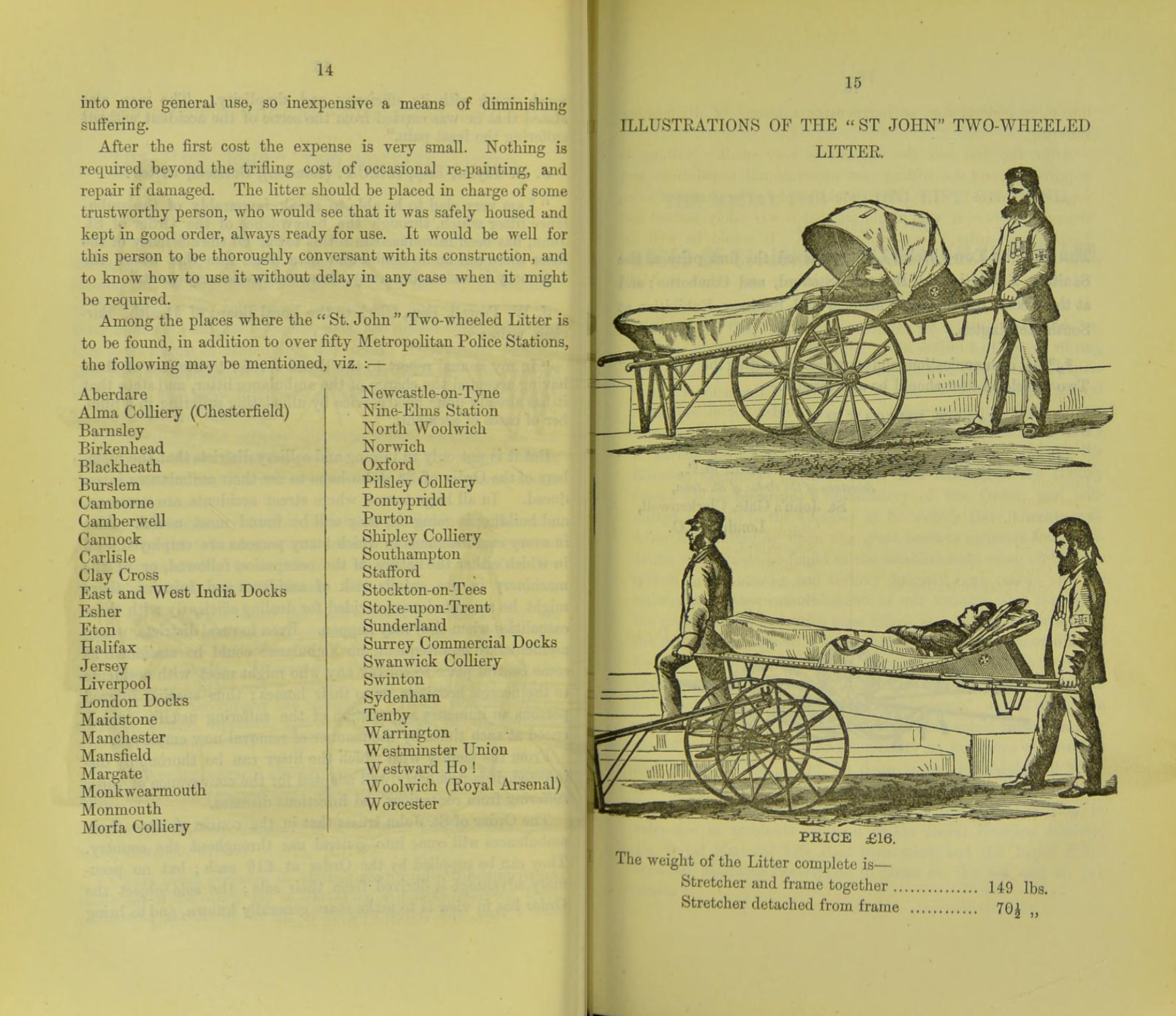
Hiram Syson’s story is one of quiet revolution. In an age when few services existed for those injured in everyday life, he brought dignity, urgency, and care to the people of Burslem. Drawing on his experience as a soldier and hospital orderly, he stepped into a pioneering role that didn’t yet have a name – and made it indispensable. As England’s first known civilian ambulance man, he laid the foundations for a public service that would go on to save countless lives across the country.
But Hiram was more than a historic first – he was a man who earned the admiration of his community through hard work, humility, and service. He became a local hero not with grandeur, but with grit. Whether responding to fires, tending to the wounded, or leading with calm resolve, he showed what one determined individual could achieve with limited resources but limitless heart.
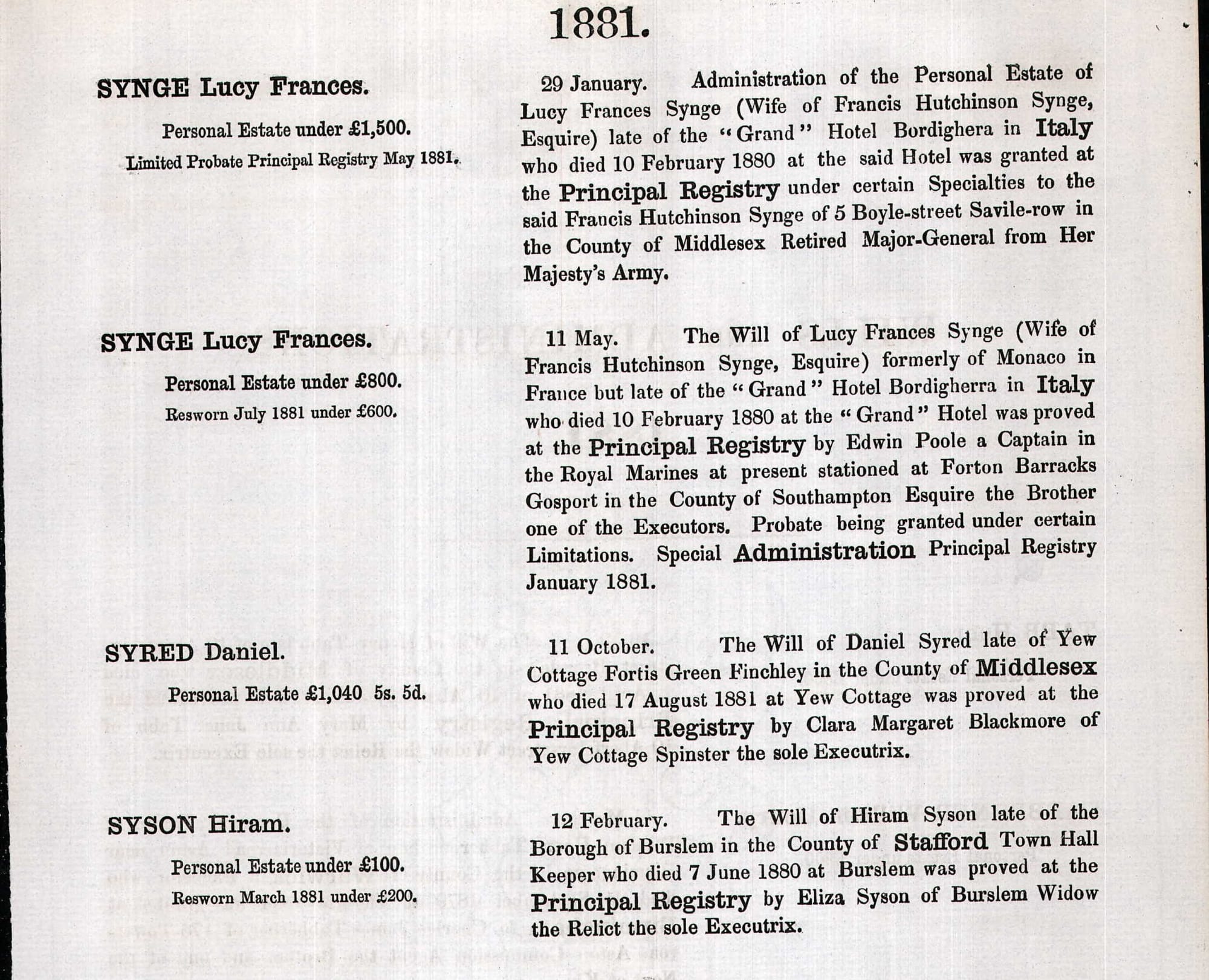
His legacy lives on not only through the institutions that followed – the St John Ambulance Association, the Brigade, and countless ambulance services nationwide – but also through the lives of those he helped, the community he protected, and the history he helped write.
Today, as ambulances race to emergencies in towns and cities across the UK, their origins can be traced back to the Town Hall steps of Burslem, Stoke-on-Trent, where a man named Hiram Syson once carried the injured on a two-wheeled cart – with courage, care, and the hope of a better way.
May his name always be remembered as the First Ambulance Man.


Much of the information in my article was informed by the excellent research in this book, which provided a vital foundation for my own work. I’ve also included additional research and interpretation, but I highly recommend the book for those wanting to explore further. You can purchase it here.

